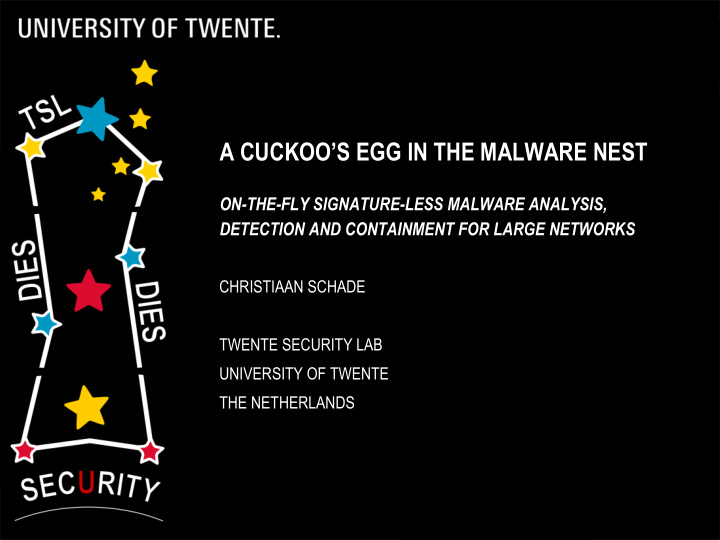



A CUCKOO’S EGG IN THE MALWARE NEST ON-THE-FLY SIGNATURE-LESS MALWARE ANALYSIS, DETECTION AND CONTAINMENT FOR LARGE NETWORKS CHRISTIAAN SCHADE TWENTE SECURITY LAB UNIVERSITY OF TWENTE THE NETHERLANDS
MALWARE WARS Ø In the last half-decade malware has evolved into a business q Windows is the most attacked platform, OS X also affected Ø Symantec & Co show impressive growing rates o Use of polymorphism/packers o Malware writers are just better J Ø Dynamic Malware Analysis (DMA) q Malware samples are executed in a sandbox q Analysis results are used to update AV signatures and “detection models” q Anubis, CWSandbox, Malheur, Malnet, etc. Christiaan Schade 12/19/11
LIMITATIONS OF DMA Ø Malware writers implemented several countermeasures to avoid/slow down the DMA analysis q Runs only when user(s) is actually logged in q Waits for a certain time frame before activating (10-15 mins) q Checks for virtualization / known registry keys / known IPs Ø DMA tools usually perform post-mortem analysis à users submit their sample(s) and get a report back q Limited support to monitor an internal network and protect endpoints q If you submit a sample, you already suspect it is malware … and your AV likely did not detect it (otherwise … why submit it for further analysis? Ø DMA tools lack information about the execution context and do not offer real-time protection Christiaan Schade 12/19/11
THE IDEA Ø ~30% of current malware download additional components once running q Require some external “content providers”, usually early compromised servers q Content providers might not be online, malware will often need to run several download attempts Ø If we can detect one of these attempts, we can feed the malware with a crafted executable (we call it “cuckoo’s egg”) that: q Will perform some real-time analysis at the end host à on-the-fly malware analysis q Can be instructed to terminate its parent process à effective containment Christiaan Schade 12/19/11
GENERAL ARCHITECTURE WE CALL IT AVATAR Christiaan Schade 12/19/11
LAYING THE EGG… Ø We use an algorithm based on TWR to detect “too many” failed attempts, then the egg generator: q Checks the requested filename q Checks magic numbers in case a file is successfully fetched after several attempts q Packs and sends the cuckoo’s egg when # attempts > threshold Ø When the egg is executed on the target machine, it attempts to get control over its parent process q Depending on the OS version the egg can freeze/terminate the process Christiaan Schade 12/19/11
…AND PARASITE! Ø The egg collects several information about the parent process: q Path to the exe q Any module that was loaded (full module paths) q Window (if any is attached) information: handle, size, caption text q Executable size Ø The collected information are sent to the MAE, which can stop the egg or perform deeper analysis q The egg can send back to the MAE the original parent executable Christiaan Schade 12/19/11
LIMITATIONS TO OUR APPROACH Ø Malware could initiate connections at a very low rate à this would slow down the infection though Ø Malware could apply some verification/encryption mechanisms to the downloaded components à keys could be disclosed Ø Malware writers could use steganography to hide executables into other file formats (e.g., JPEG, like the recent Duqu) Ø Malware could leverage the CreateRemoteThread function to execute its code into another process Christiaan Schade 12/19/11
TESTS Ø Avatar has been tested against real-life malware samples q CWSandbox data set, available at Malheur’s web site q everyday malware we all receive in our mailbox J Ø Dataset A – PoC q ~10 malware families, huge collection (almost) publicly available from the authors of Malheur (2009) à 75 samples Ø Dataset B – evaluation of false positives/negatives q everyday malware we received in our mailboxes during a week time à 30 samples + 30 benign samples Christiaan Schade 12/19/11
TEST RESULTS – DATASET A Christiaan Schade 12/19/11
TEST RESULTS – DATASET B Christiaan Schade 12/19/11
CONCLUSION Ø Avatar raises the bar of malware analysis q No software is required to run at the endpoint q Delivers on-the-fly any component needed for analysis q Heavy computations are off-loaded q We can stop a malicious process as soon as it is detected (to some extent, depending on the OS) Ø We know it can be circumvented, but this will also make it more difficult for malware writers q No countermeasure has been observed so far in our tests Christiaan Schade 12/19/11
DEMO Christiaan Schade 12/19/11
QUESTIONS ? Christiaan Schade 12/19/11
Recommend
More recommend